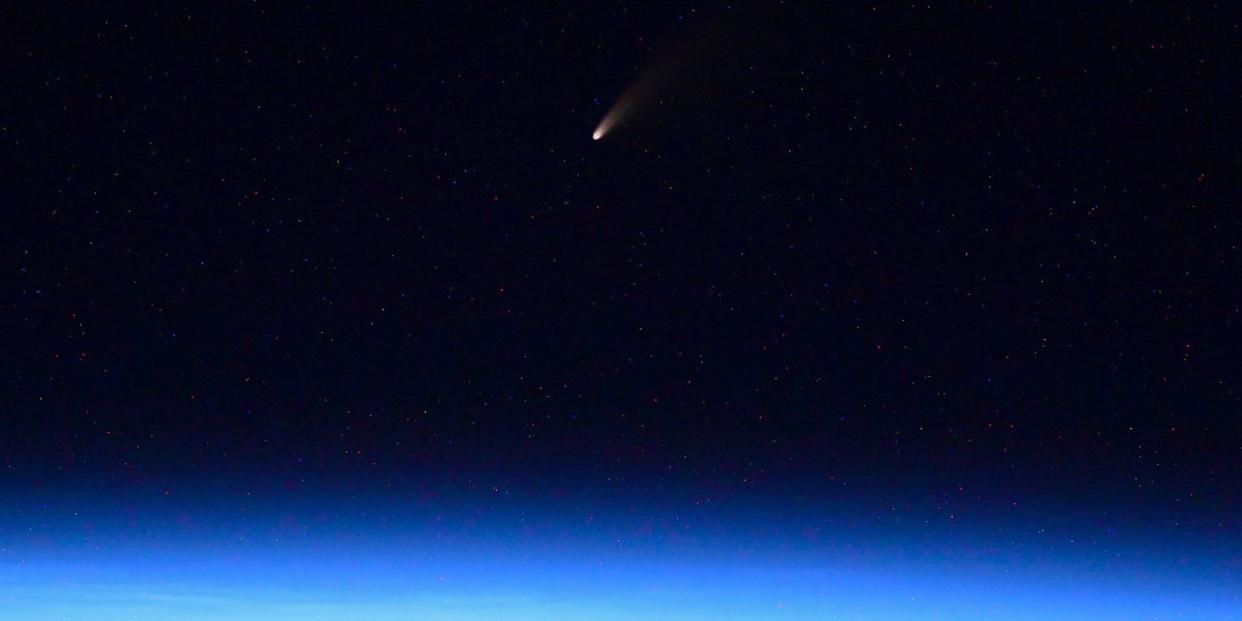A Naked-Eye Comet Is Soaring Through the Sky—Here's How to See It

A new comet, C/2020 F3 (NEOWISE), is now visible to the naked eye in the northern hemisphere.
The Near Earth Object Wide-field Infrared Survey Explore (NEOWISE) telescope first spotted the comet on March 27.
You can spot the comet for almost the entire month of July.
There's a new comet in town. C/2020 F3, also known as NEOWISE, has arrived—and you can actually see it with your naked eye. The comet is most visible before dawn and after dusk, and it's already causing quite a stir.
Comet Neowise photographed in #Tucson about an hour ago! #cometneowise #NEOWISE pic.twitter.com/UFYu8Ia0XK
— Sean Parker (@seanparkerphoto) July 8, 2020
NEOWISE is named for the telescope that discovered it. The Earth-orbiting space telescope Near Earth Object Wide-field Infrared Survey Explorer, which launched in 2009, first spotted the comet on March 27.
While the comet is relatively bright, with a magnitude of around +1, it's not likely to go down in the history books as one of the "great" naked-eye comets. Comet Hale-Bopp (1997) and Comet McNaught (2006) are two recent examples of great comets that have swooped through the skies.
On July 3, NEOWISE reached perihelion, or the closest point in its orbit to the sun, according to Space. It survived its 27.3 million-mile brush with the sun and will make its closest approach to Earth on July 22.
In the meantime, the best time to spot the comet is about 80 minutes before dawn across the northeastern horizon. NEOWISE will reach its highest point in the sky around July 11. Then, around July 12 to 15, the comet will be visible 80 minutes after dusk over the northwestern horizon. While we have a pretty good view on Earth, astronauts aboard the International Space Station have a front-row seat.
Comet NEOWISE from ISS, July 5th pic.twitter.com/pAbGdtchAc
— Seán Doran (@_TheSeaning) July 7, 2020
Comets are already having something of a moment. In 2019, astronomers announced the discovery of the comet C/2019 Y4 (ATLAS), which they expected to be visible with a pair of binoculars throughout April 2020. But as it soared close to the sun, it dimmed and eventually split apart.
Another comet, C/2020 F8 (SWAN), showed promise earlier this year when astronomers spotted it with the Solar Wind Anisotropies camera aboard NASA's Solar and Heliospheric Observatory. Unfortunately, a spectacular show wasn't in the cards. It fizzled out in early May.
If you have comet fever, there are others sailing through the night sky, but you'll need a set of binoculars or a telescope to view them. While they're not quite as bright as NEOWISE, you can track them on comet king Seiichi Yoshida's website.
You Might Also Like


